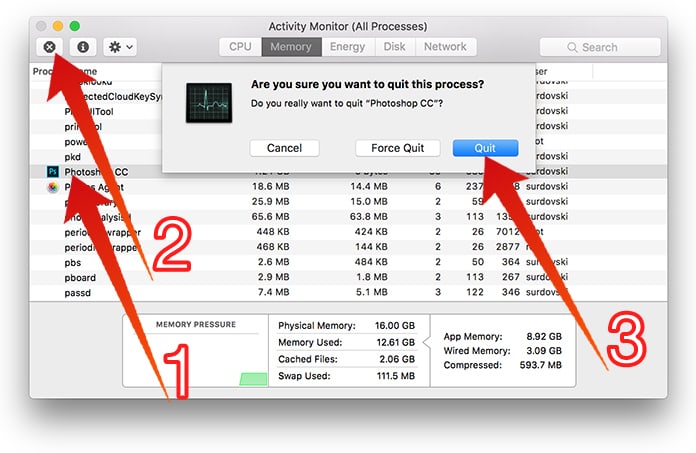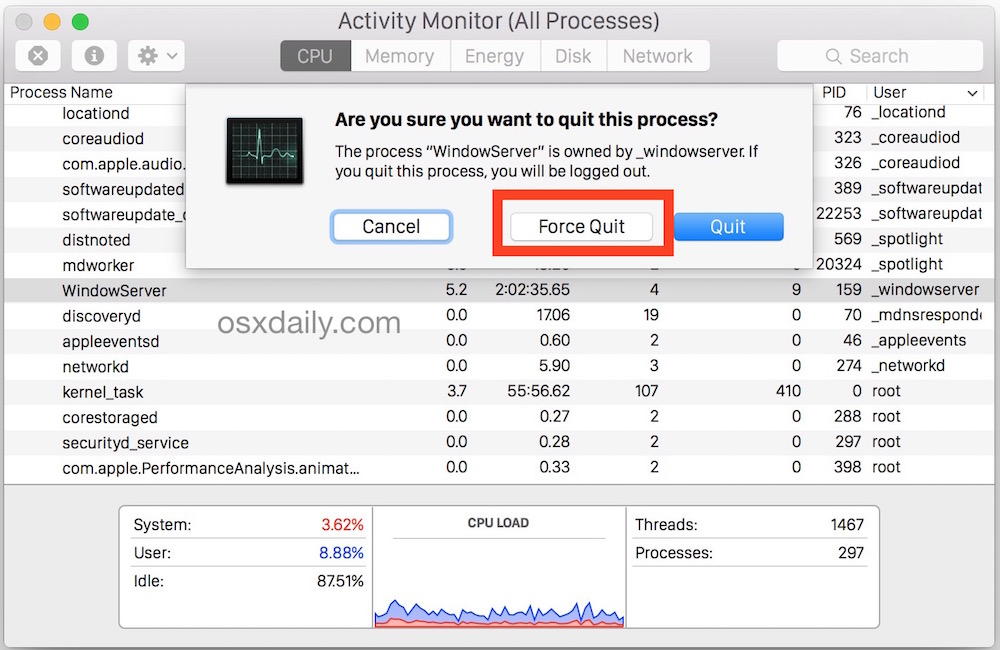Quit All Apps Mac Terminal
How to force a Mac application to quit The safest route. Try Command-Q keystroke, even if it doesn't appear to do anything. It's possible that the app will. If the app doesn't respond after a couple of minutes, use macOS's Force Quit. We're not saying Apple knows. When all else. Aug 12, 2016 One way to do that is by holding option when clicking on the relevant dock icon and selecting 'Force Quit'. Do you mean force quit ALL applications? I don't think there is a graceful way to do that. A brutal way to do it is to force quit the WindowServer process via. Another method to check all the Running apps and programs on your Mac is through the Force Quit applications manager on Mac. Click on the Apple icon in the top menu bar of your Mac and then click on Force Quit Application in the drop-down menu (See image below).
When you run any command in the OS X Terminal, you are running some program that has been coded and compiled to perform a specific function, be it something simple like “ls” to list directory contents, or something more interactive like “top” to display information on running processes. These commands are all programs on your Mac, just like applications such as Pages, Word, TextEdit, and Safari that have graphical interfaces and are the main productivity programs you use when running OS X.
Opening Applications using the Terminal
Most applications in OS X are opened by using a graphical approach like mouse click actions or services like Spotlight; however, you can also open applications using the OS X Terminal. This might seem unnecessary, but it can have its uses. For instance, I have a Mac Mini running the third-party media center software “XBMC” on it. This software sometimes crashes and needs to be relaunched, so while I can screen share to it or rummage for my wireless mouse and keyboard to access it, another approach if I am at my laptop is to simply log in with SSH and use one of several command options for opening the program.
1. Direct executable execution
Applications in OS X are packaged as bundles, which are folders including the executable along with any supporting resources (libraries, images, fonts, etc.) that the program needs to run. You can see these by right-clicking any application and choosing the option to “Show Package Contents.” In this bundle structure, the application executable is located in the /Contents/MacOS/ directory, and can be launched directly in the Terminal by specifying the full path to this executable. For example, you can open Safari by running the following command:
While this will open the specified program, this method has some limitations and restrictions that might cause problems. For one, the program will be launched as a child process of the current Terminal window, so if you close the Terminal window you will close the program. In addition, such behaviors might interfere with Apple’s Resume service and not save any of your open windows for the next time you re-launch your program.2. The “open” command
My preferred method of opening an application from the Terminal is to use the “open” command with the the “-a” flag to specify the application by name. For example, the following command will open Safari:
This approach mimics opening the program using the graphical interface, and can be useful if you are creating scripts where you would like to open a specific application. You can also use many of the “open” command’s options to do things like launch a new instance of a program (though this may conflict with OS X’s Resume service), or open a program in the background. In addition, since the “open” command launches applications indirectly, once run you can simply close the Terminal window and the application will remain open, as opposed to using direct executable execution.
Open OBS, and click on ‘Settings’. There are two ways you can do this—either access the ‘Settings’ option through ‘File’ or just click on it from the bottom right corner. Click on the ‘Stream’ option in the resulting window. Select the Apple menu, and select System Preferences. In System Preferences, select Security & Privacy. On the General tab, at the bottom, your Mac will remember you just tried to open the OBS installer. Select Open Anyway. Your Mac will ask if you are sure, select Open. Jul 20, 2019 OBS Settings for Best Screencast: Today, I am going to tell you how to set your Open Broadcaster Software(OBS) video display settings to be perfect for recording. First, Click on Settings, which is at the bottom right corner. Select Output from the. May 09, 2020 Streamlabs OBS for MacOS is here! In this video we'll walk through setting up Streamlabs step by step. We'll install Streamlabs OBS, set up desktop audio with iShowU Audio Capture so you can capture desktop audio, configure our webcam and game capture with a Cam Link, set up our alerts, configure the best possible streaming settings for Streamlabs, adjust our streaming layout, and go live. Open broadcaster software mac best settings.
The “open” command is also useful because you can cleanly launch applications for the current user account on a remote system. For instance, in looking at the XBMC setup on my Mac Mini, when XBMC crashes I can use “ssh” to remotely log in as the current username and then simply run “open -a XBMC” to quickly re-launch it.
3. Osascript approaches
The “osascript” command is OS X’s Terminal command for running “open scripting architecture” scripts like AppleScript. Since with AppleScript you can instruct the system to do things like launch applications, with a relatively basic scripting line like ‘open app “APPNAME”‘ coupled with the “osascript” command, you can create a quick one-line command to open any application on the system. For example, the following command will launch Safari similar to the “open” command above:

Keep in mind that as with the “open” command, this will also require you to be logged into the system as the currently active user. Otherwise you will get an error (-10810) at the Terminal and the specified application will not open.
Quitting Applications using the Terminal
Applications iphoto.app contents macos iphoto 2017. Type the following command to open iPhoto in Mac. /Applications/iPhoto.app/Contents/MacOS/iPhoto & But if you opt for this option, you will have to open the iPhoto app by typing the command in the terminal every time you want it to get launched.
While the “open” command is great for launching applications, this approach will only open them and does not provide a way to quit them. Therefore, the AppleScript approach with the “osascript” command may be the easiest way to cleanly quit a running application using the Terminal. For example, given the command above to open Safari, you can use the following one to easily quit it:
Note that while this will attempt to quit programs, if you have unsaved changes in them and a Save dialogue box or other notice pops up that requires user input to proceed, then the program will not quit.
Force-quitting Applications using the Terminal
If you need to force-quit an application using the Terminal, then this can be done in two ways. The first is to simply use the “killall” command, which allows you to specify a program by name and then the system will internally identify it and close it down. The following command is a way to force-quit Safari (since we’ve been using this as an example so far):
In addition to this, for those who like to delve a little deeper into the Terminal, you can first find the process ID (PID) of the running application and then use the standard “kill” command to force-quit it. There are several ways to get the PID of a running application, but an easy one in the Terminal is to use the “pgrep” command and specify the program name. For example, to do so with Safari you would run the following command:
If Safari is running, then this command will output a single number that is the program’s PID. You can then use “kill PID” (replacing PID with the number) to quit Safari. This approach is a two-step process, but you can lump it all into one command by nesting them together using grave accent symbols to encase the “pgrep” command, such as the following:

Close All Apps Mac Terminal
What these accent symbols do is first execute the “pgrep Safari” command, and then use the result when running the “kill” command. Therefore, this essentially finds the PID for Safari, and then kills the specified PID.